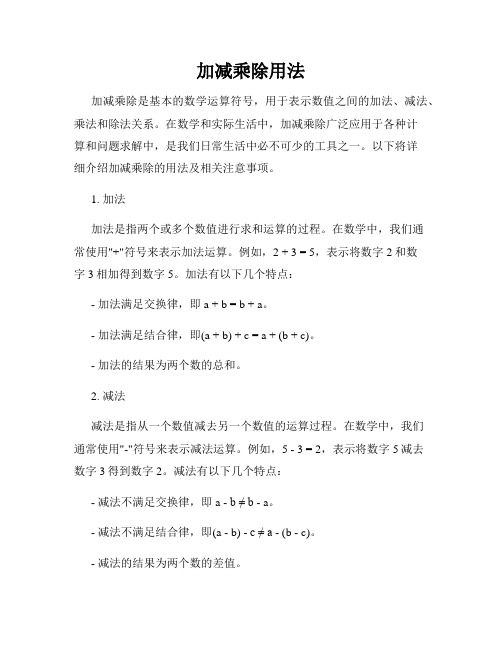数词的用法 加减乘除教学文案
九年级英语数词用法总结 教案

九年级英语数词用法总结一. 本周教学内容数词用法总结二. 知识归纳与总结A. 基础知识(一)数词的分类:表示数目多少或顺序的词叫数词。
数词分为基数词和序数词。
表示数目多少的数词叫基数词。
one,two表示顺序次第的数词叫序数词。
the first(第一)、the second(第二)(二)数词的用法:1.作主语Thirty of them are Party members.他们之中的三十人是党员。
2.作宾语Please pass me the second.请递给我第二个。
3.作定语The nine boys are from Tianjin.这九个男孩子是某某人。
4.作表语Six plus four is ten.六加四等于十。
5.作同位语(只限基数词)We four will go with you.我们四个人将和你一起去。
B. 用法总结(一)基数词的表示方法:1. 1—12 的基数词:one, two, three, four, five, six, seven, eight, nine, ten, eleven, twelve2. 13~19的基数词,在个位数上加后缀-teen构成,并有两个重音。
thirteen, fourteen, fifteen, sixteen, seventeen, eighteen, nineteen3. 20~90等十位数由2—9 加后缀-ty构成。
twenty, thirty, forty, fifty, sixty, seventy, eighty, ninety4. 21—29由十位数20加个位数1—9 构成,十位和个位之间加连字符号“-”,其他十位数以此类推。
21 twenty-one、44 forty-four、98 ninety-eight5. 多位数的读法①从后向前数,每三位数加一个“,”;第一个“,”号前为thousand(千),第二个“,”号前为million(百万)……,然后再逐段表达。
初中数词教案教案

初中数词教案教案一、教学目标:1. 让学生掌握数词的分类和基本用法,能够正确运用数词描述事物和数量。
2. 培养学生运用数词进行交流和思维的能力,提高学生的数学素养。
3. 通过对数词的学习,培养学生对数学的兴趣,激发学生的学习积极性。
二、教学内容:1. 数词的分类:整数、分数、小数、负数。
2. 数词的用法:表示数量、顺序、比例等。
3. 数词的运算:加减乘除、乘方、开方等。
三、教学重点与难点:1. 重点:数词的分类和基本用法。
2. 难点:数词的运算和应用。
四、教学方法:1. 情境教学法:通过生活实例和数学问题,让学生在实际情境中学习和运用数词。
2. 小组合作学习:让学生在小组内讨论和探究数词的用法和运算规律。
3. 游戏教学法:通过数词游戏,激发学生的学习兴趣,提高学生的学习积极性。
4. 任务驱动法:布置数学任务,让学生在完成任务的过程中,巩固数词知识和提高应用能力。
五、教学步骤:1. 导入新课:通过数数游戏,引导学生进入数词学习的情境。
2. 讲解数词分类:讲解整数、分数、小数、负数的定义和特点。
3. 演示数词用法:通过生活实例和数学问题,讲解数词表示数量、顺序、比例等。
4. 数词运算练习:讲解加减乘除、乘方、开方等运算规则,并进行练习。
5. 小组讨论:让学生在小组内讨论数词的用法和运算规律,分享学习心得。
6. 任务驱动:布置数学任务,让学生在完成任务的过程中,运用数词知识和提高应用能力。
7. 总结与反馈:对本节课的学习内容进行总结,对学生的学习情况进行反馈,查漏补缺。
六、课后作业:1. 复习数词的分类和基本用法。
2. 完成数词运算练习题。
3. 运用数词解决实际问题,如购物、测量等。
4. 总结数词的学习方法和技巧,撰写学习心得。
通过以上教学设计,相信学生能够掌握数词的基本知识和应用能力,激发对数学的兴趣,提高数学素养。
在教学过程中,教师要关注学生的个体差异,因材施教,使每个学生都能在数词学习中获得成功。
数词的用法教案

数词的用法教案(共7页)--本页仅作为文档封面,使用时请直接删除即可----内页可以根据需求调整合适字体及大小--一、复习预习教师引导学生复习上节内容,并引入本节课程内容二、知识讲解1.基数词表示数目的词称为基数词。
其形式如下:A.从1——10one,two,three,four,five,six,seven,eight,nine,ten.B.从 11——19eleven,twelve, thirteen, fourteen, fifteen, sixteen, seventeen,eightee n, nineteen.这里除 eleven, twelve, thirteen, fifteen, eighteen为特殊形式外,fourtee n,sixteen,seventeen,nineteen都是由其个位数形式后添加后缀-teen构成。
C.从 21——99整数几十中除twenty,thirty, forty,fifty,eighty为特殊形式外,sixty,sevent y,ninety都是其个位数形式后添加后缀-ty构成。
表示几十几时,在几十和个位基数词形式之间添加连字符“-” 21 twenty-one 76 seventy-sixD.百位数个数基数词形式加“hundred”,表示几百,在几十几与百位间加上and. 10 1 a hundred and one 320 three hundred and twenty 648 six hundred and forty-eig htE.千位数以上前的数字后添加 thousand,第二个“,”前面的数字后添加 million,第三个“,”前的数字后添加 billion。
然后一节一节分别表示,两个逗号之间最大的数为百位数形式。
2,648 two thousand six hundred and forty-eight16,250,064 sixteen million two hundred and fifty thousand sixty-four 5,237,166,23 4 five billion,two hundred and thirty-seven million,one hundred and sixty-six tho usand,two hundred and thirty-four1)F.基数词在表示确切的数字时,不能使用百、千、百万、十亿的复数形式;但是,当基数词表示不确切数字,如成百、成千上万,三三两两时,基数词则以复数形式出现如:There are hundreds of people in the hall.大厅里有数以百计的人。
数词的运用小班数学教案

数词的运用小班数学教案引言:数词是描述和表示数目数量的词语,它在数学中起着非常重要的作用。
数词不仅能够帮助我们理解和比较数字之间的大小关系,还可以在日常生活中应用于计数、测量、排列等各种场景。
本文将介绍一份小班数学教案,内容涵盖了数词的基本概念和运用,旨在帮助学生掌握数词的使用方法。
一、目标:通过本节课的学习,学生将能够:1. 理解数词的基本概念和作用;2. 掌握数词的基本用法,包括基数词和序数词;3. 运用数词进行计数、测量和排序。
二、教学重难点:1. 数词的分类和用法;2. 数词在实际生活中的应用。
三、教学内容和方法:1. 数词的基本概念和分类(板书):- 数词是描述和表示数目数量的词语;- 数词分为基数词和序数词。
2. 数词的基础运用:- 基数词用于计数,描述数量的大小;- 示例1:板书“5个苹果”、“10只猫”等,让学生理解基数词的用法;- 示例2:出示一些图片,让学生观察并用基数词描述图片上的物体数量;- 练习1:每个学生拿出一定数量的小球,向其他同学报数。
3. 序数词的运用:- 序数词用于表示顺序或次序;- 示例1:板书“第一名”、“第二页”等,引导学生理解序数词的意义;- 示例2:出示一些图片,让学生观察并用序数词描述图片上的物体顺序;- 练习2:列出几个学生的名字,让学生按照字母顺序排列。
4. 数词的应用扩展:- 数词在实际生活中的应用很广泛,比如时间、年龄、温度等;- 示例1:板书“2点钟”、“3岁”、“30摄氏度”等,让学生理解数词在不同场景下的用法;- 示例2:提出一些日常问题,让学生用数词回答,如“你家有几口人?”、“你的生日是几月几号?”等;- 练习3:让学生参与游戏,根据指令和数词完成相应动作,如“跳一下”、“向左走两步”等。
四、教学延伸:1. 数词的进阶运用:- 数词可以与其他词汇组合,形成更复杂的表达方式;- 示例1:“一百个苹果”、“第三位同学”等,让学生理解复合数词的用法;- 示例2:出示一些句子,让学生分析并理解句子中数词的用法。
小升初数词模块教案

小升初数词模块教案一、教学目标:1. 让学生掌握数词的读写规则,能够正确书写和朗读1-100的数字。
2. 让学生理解数词的组成,掌握10的倍数的表达方式。
3. 培养学生运用数词进行基本的数学运算能力。
二、教学内容:1. 数词的读写规则:奇数与偶数的读写,0的读写,十位与个位的读写。
2. 10的倍数的表达方式:10的倍数(包括10, 20, 30……100)的读写与理解。
3. 基本数学运算:加减乘除的简单运算,运用数词进行计算。
三、教学重点与难点:1. 重点:数词的读写规则,10的倍数的表达方式。
2. 难点:数词在实际运算中的应用。
四、教学方法:1. 采用直观演示法,通过实物、图片等引导学生直观地理解数词。
2. 采用游戏教学法,设计有趣的游戏,让学生在游戏中掌握数词。
3. 采用分组合作法,让学生分组进行讨论和实践,培养团队协作能力。
五、教学步骤:1. 导入新课:通过数数游戏,引导学生进入数词学习。
2. 讲解数词的读写规则:讲解奇数与偶数的读写,0的读写,十位与个位的读写。
3. 学习10的倍数的表达方式:让学生朗读和书写10的倍数(包括10, 20, 30……100)。
4. 实践练习:进行数词书写和朗读的练习,纠正错误。
5. 基本数学运算:讲解加减乘除的简单运算,运用数词进行计算。
6. 课堂小结:总结本节课所学内容,强调重点和难点。
7. 作业布置:布置相关数词书写、朗读和运算的练习题。
六、教学评价:1. 采用课堂问答法,检查学生对数词读写规则的掌握情况。
2. 通过小组竞赛,检验学生对10的倍数表达方式的熟悉程度。
3. 设计课后练习题,评估学生对数词运算能力的掌握。
七、课后作业:1. 数词书写练习:请学生独立完成1-100的数字书写。
2. 数词朗读练习:请学生录制自己朗读1-100数字的视频。
3. 数词运算练习:完成5道简单的加减乘除题目。
八、课程拓展:1. 邀请数学老师进行跨学科教学,让学生了解数词在数学中的应用。
初中数词的教案

初中数词的教案教案标题:初中数词的教案教案目标:1. 理解和掌握初中数词的基本概念和用法。
2. 能够正确运用数词进行计数和排序。
3. 培养学生对数词的敏感性和运用能力。
教学重点:1. 数词的基本概念和分类。
2. 数词的读法和用法。
3. 数词的计数和排序。
教学难点:1. 掌握数词的读法和用法。
2. 运用数词进行计数和排序的能力。
教学准备:1. 教材:初中数学教材。
2. 教具:黑板、白板、彩色粉笔、图片、卡片等。
3. 辅助资料:数词的分类和用法总结。
教学过程:Step 1: 引入1. 利用图片或实物展示一些数量,如苹果、书本等,引导学生讨论数量的表达方式。
2. 提出问题:“你知道如何用数词来表示这些数量吗?”Step 2: 数词的分类和读法1. 介绍数词的分类:基数词和序数词。
2. 通过示例和练习,让学生掌握数词的读法和用法。
3. 引导学生发现数词的规律,如基数词以“-ty”结尾,序数词以“-th”或“-st”结尾等。
Step 3: 数词的计数和排序1. 通过图片、卡片等展示物品,让学生用数词进行计数。
2. 引导学生掌握数词的计数规则,如“one”后面接单数名词,“ones”后面接复数名词等。
3. 给学生一些计数和排序的练习题,巩固他们的运用能力。
Step 4: 拓展应用1. 引导学生在日常生活中运用数词,如购物、时间、年龄等方面。
2. 给学生一些拓展应用的练习题,提高他们的运用能力和思维能力。
Step 5: 总结和评价1. 总结数词的基本概念和用法。
2. 针对学生的学习情况,进行个别评价和指导。
教学延伸:1. 鼓励学生在日常生活中积极运用数词,提高他们的数词意识和运用能力。
2. 给学生一些拓展练习和挑战,培养他们的数学思维和解决问题的能力。
教学反思:1. 教学过程中要注重启发学生思考和参与互动,激发他们的学习兴趣。
2. 针对学生的不同水平和特点,采用灵活多样的教学方法和手段。
3. 注重巩固和拓展,提高学生的数词运用能力和思维能力。
加减乘除用法

加减乘除用法加减乘除是基本的数学运算符号,用于表示数值之间的加法、减法、乘法和除法关系。
在数学和实际生活中,加减乘除广泛应用于各种计算和问题求解中,是我们日常生活中必不可少的工具之一。
以下将详细介绍加减乘除的用法及相关注意事项。
1. 加法加法是指两个或多个数值进行求和运算的过程。
在数学中,我们通常使用"+"符号来表示加法运算。
例如,2 + 3 = 5,表示将数字2和数字3相加得到数字5。
加法有以下几个特点:- 加法满足交换律,即a + b = b + a。
- 加法满足结合律,即(a + b) + c = a + (b + c)。
- 加法的结果为两个数的总和。
2. 减法减法是指从一个数值减去另一个数值的运算过程。
在数学中,我们通常使用"-"符号来表示减法运算。
例如,5 - 3 = 2,表示将数字5减去数字3得到数字2。
减法有以下几个特点:- 减法不满足交换律,即a - b ≠ b - a。
- 减法不满足结合律,即(a - b) - c ≠ a - (b - c)。
- 减法的结果为两个数的差值。
3. 乘法乘法是指两个数值相互相乘的运算过程。
在数学中,我们通常使用"×"符号或者"·"符号来表示乘法运算。
例如,2 × 3 = 6 或者 2 · 3 = 6,表示将数字2乘以数字3得到数字6。
乘法有以下几个特点:- 乘法满足交换律,即a × b = b × a。
- 乘法满足结合律,即(a × b) × c = a × (b × c)。
- 乘法的结果为两个数的积。
4. 除法除法是指一个数值被另一个数值整除的运算过程。
在数学中,我们通常使用"÷"符号或者" / "符号来表示除法运算。
例如,6 ÷ 3 = 2 或者 6 / 3 = 2,表示将数字6除以数字3得到数字2。
数词的用法 加减乘除

第33课数词之加减乘除算术式的读法:※加法1.在口语中的小数目的加法:用and代表“+”号,is或are 代表“?号。
如:Five and three is (or are) eight.5 + 3 = 8What's seven and eight?7 + 8 = ?2.大数目的加法,或在比较正式的场合──用plus代表“+”号,equals或is代表“?”号。
如:What does Two hundred and thirty-one plus a hundred and sixty-three equal?(or: What is Two hundred and thirty-one plus a hundred and sixty-three?)231 +163 = ?※减法1.在口语中的小数目的减法──可用以下两种方式:方法一:被减数+take away+减数+leaves (or is) +余数方法二:减数+from+被减数+leaves (or is) +余数Four from nine leaves (or is) five.or: Nine take away four leaves (or is) five.9 - 4 = 5.2.大数目的减法或在比较正式的场合──用minus代表“-” 号,equals代表“?”号。
如:Four hundred and thirty-one minus a hundred and sixty-threeequals two hundred and sixty-eight, right or wrong?431 - 163 = 268※乘法1.口语中小数目的乘法──第二个数目用复数形,等号用are 表示。
如:What are three tens?3 &#x D7;10 = ?Five eights are forty.5 &#x D7;8 = 402.大数目的乘法用times代表“&#x D7;”号,is或makes代表“=”号;在比较正式的场合用multiplied by代表“&#x D7;”号,equals代表“?”号。
- 1、下载文档前请自行甄别文档内容的完整性,平台不提供额外的编辑、内容补充、找答案等附加服务。
- 2、"仅部分预览"的文档,不可在线预览部分如存在完整性等问题,可反馈申请退款(可完整预览的文档不适用该条件!)。
- 3、如文档侵犯您的权益,请联系客服反馈,我们会尽快为您处理(人工客服工作时间:9:00-18:30)。
第33课数词之加减乘除算术式的读法:※加法1.在口语中的小数目的加法:用and代表“+”号,is或are 代表“?号。
如:Five and three is (or are) eight.5 + 3 = 8What's seven and eight?7 + 8 = ?2.大数目的加法,或在比较正式的场合──用plus代表“+”号,equals或is代表“?”号。
如:What does Two hundred and thirty-one plus a hundred and sixty-three equal?(or: What is Two hundred and thirty-one plus a hundred and sixty-three?)231 +163 = ?※减法1.在口语中的小数目的减法──可用以下两种方式:方法一:被减数+take away+减数+leaves (or is) +余数方法二:减数+from+被减数+leaves (or is) +余数Four from nine leaves (or is) five.or: Nine take away four leaves (or is) five.9 - 4 = 5.2.大数目的减法或在比较正式的场合──用minus代表“-” 号,equals代表“?”号。
如:Four hundred and thirty-one minus a hundred and sixty-threeequals two hundred and sixty-eight, right or wrong?431 - 163 = 268※乘法1.口语中小数目的乘法──第二个数目用复数形,等号用are 表示。
如:What are three tens?3 &#x D7;10 = ?Five eights are forty.5 &#x D7;8 = 402.大数目的乘法用times代表“&#x D7;”号,is或makes代表“=”号;在比较正式的场合用multiplied by代表“&#x D7;”号,equals代表“?”号。
如:What does fifteen times two hundred and sixty-nine make?(or : What is fifteen times two hundred and sixty-nine?)15 &#x D7;269 = ?15 &#x D7;289 = 433515 multiplied by 289 equals 4335.※除法1.小数目的除法有两种方式:方法一:用divided by 代表“&#x F7;”号,equals代表“?”号。
方法二:除数+into+被除数+goes+余数──用于会话中。
Three into eighteen goes five.or: Eighteen divided by three equals five.18 &#x F7;3 = 5.2.大数目的除法同方法一。
What does six hundred and sixty-seven divided by twenty-threeequal?667 &#x F7;23 = ?第34课awake or asleep?----只用于叙述的形容词一. 放在联系动词或动词的被动语态后,解释主语的形容词,和放在动词+宾语后,解释宾语的形容词都属于形容词的叙述用法。
二. 形容词 afraid(恐怕), asleep(睡着), awake(醒来),alike(相似的), alone(孤单的), alive(活着的), apart(分隔的;意见分歧的)等只能(或多数情况下)作叙述用法。
这些形容词一般不能直接用副词very修饰。
Hi, Mary, are you all alone by yourself?嗨,玛丽,就你自己一个人吗?You men are very much alike.你们男人都一个样儿。
Hey, are you awake or asleep?嘿,你是醒着还是睡着呢?I doubt whether he is still alive.我怀疑他是否还活着。
I am really afraid now.我现在真的害怕了。
第35课副词的位置与排列一. 副词的位置(一) 1.副词可以修饰动词,包括不定词、动名词和分词,通常位于被修饰的动词后面;修饰及物动词时,一般放在宾语的后面。
They walked slowly.他们走得很慢。
slowly修饰动词walked。
The snow continued to fall heavily.雪继续下得很大。
heavily修饰不定词to fall。
I enjoy driving slowly in the golden morning sun.我喜欢在清晨金色的阳光下悠然地驾车。
slowly修饰动名词driving。
I enjoy walking slowly in the golden morning sun.我喜欢在清晨金色的阳光下悠然地散步。
slowly修饰动名词walking。
We saw a boat coming quickly toward us.我们看到小船很快地朝我们驶来。
quickly修饰现在分词coming。
Taken separately, they are easy to solve.分开处理容易解决。
separately修饰过去分词taken。
2.副词修饰动词,放在句首时,起强调的作用。
Quickly, he stood up to catch the butterfly.他飞快地站起来去捉蝴蝶。
3.肯定否定副词或频率副词多置于一般动词之前,但通常要放在助动词、联系动词BE之后。
He never spoke about his own merits.他从不说起他自己的功绩。
We may never see him again.我们也许再也见不到他。
He is often late for school.他常上学迟到。
(二)修饰形容词的副词通常放在该形容词的前面。
This is a very funny film.这是一部非常有趣的电影。
This room is fairly small.这个房间相当小。
This kitchen is not big enough.这个厨房不够大。
The number of the money is big enough.钱的数目足够大了。
副词enough修饰形容词时,要放在被修饰的形容词之后。
(三) 副词在修饰其他副词时,置于被修饰副词之前。
He drives extremely fast.他车开得非常快。
副词extremely修饰副词fast。
Do it right now.马上就做。
副词right修饰副词now。
He didn't run fast enough to catch the thief.他跑得不够快没能追上那个贼。
副词enough, indeed等在修饰副词时,置于被修饰副词之后。
(四) 副词修饰基数词时,一般置于被修饰的数词之前。
They are going to stay here fully six months.他们将要在这里停留整六个月。
副词fully修饰基数词six。
This car cost me over ten thousand dollars.这辆车花掉了我一万多美元。
副词over修饰基数词ten thousand。
(五) 副词修饰介系词片语,一般置于被修饰的介系词片语之前。
This long nail went right through the plank.这根长钉子完全穿透了木板。
副词right修饰介系词片语through the wall。
She made her application well within the term.她正好在这段期间内提出申请。
副词well修饰介系词片语within the term。
(六) 1.副词修饰子句时,一般放在被修饰的子句之前。
There was a knock at the door just as we were about to have dinner.我们正要吃晚饭的时候有人敲门。
副词just修饰副词子句as we were about to have dinner。
2.副词也可以修饰整个句子,通常位于句首,若置于句尾可能被认为是修饰动词造成语意的偏差。
Happily he went with them.他高兴地跟他们走了。
happily修饰全句。
He threw himself onto the sofa heavily.他重重地坐到了沙发上。
heavily修饰动词threw。
3.修饰全句的副词置于句中或句末时必须用逗点隔开,如无逗点隔开易被认为是修饰动词,而放在句首时则逗点可有可无。
She, apparently, wants to say something.她显然想要说点什么。
He escaped being killed in the car accident, fortunately.很幸运他没在车祸中丧命。
(七) 1.少数副词可以修饰名词及名词同等语,通常放在被修饰名词的前面,如:also, very, even, just, only, not, nearly, especially, exactly, simply, rather, quit e等。
Even a child can do it.甚至小孩也能做到。
副词even修饰名词片语a child。
Only she could come.只有她能来。
副词only修饰代名词she.2.某些副词要置于被修饰的名词之后。
I met her the week before.上星期我见过她。
副词before修饰名词week.See the notes below.参考下面的注解。
副词below修饰名词notes.He, too, loves her.他也爱她。
too修饰he,要放在he之后。
二. 副词的排列顺序1.副词的排列顺序是指在一个句子中有多个副词时,一般要按情状副词、地方副词、频率副词、时间副词的顺序排列。
The man runs slowly along the river at six o'clock every morning.这个人每天早上六点钟慢慢地沿着河边跑步。
